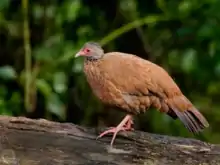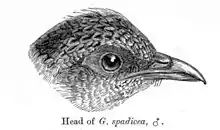Red spurfowl
The red spurfowl (Galloperdix spadicea) is a member of the pheasant family and is endemic to India. It is a bird of forests, and is quite secretive despite its size. It has a distinctive call and is often hard to see except for a few seconds when it flushes from the undergrowth. It appears reddish and like a long-tailed partridge. The bare skin around the eye is reddish. The legs of both males and females have one or two spurs, which give them their name.
| Red spurfowl | |
|---|---|
 | |
| Scientific classification | |
| Kingdom: | Animalia |
| Phylum: | Chordata |
| Class: | Aves |
| Order: | Galliformes |
| Family: | Phasianidae |
| Genus: | Galloperdix |
| Species: | G. spadicea |
| Binomial name | |
| Galloperdix spadicea (Gmelin, 1789) | |
Description

Overall reddish-brown, this large partridge-like bird has a somewhat long tail. The upper parts are brown with dark barring while the face and neck are more grey in the male. The underside is rufous with dark markings and both sexes have a red facial skin patch and red legs with one or two spurs (rarely three or four[2] while females may have none[3]). Downy chicks have an unmarked cinnamon brown head, a dark brown band along the back bordered by creamy stripes edged with thin lines of dark brown.[4] The male of the distinctive Kerala race, G. s. stewarti has all-chestnut plumage, including the head feathers.[5] Both sexes have long feathers on the crown that can be erected into a crest.[6]
Taxonomy and systematics
This spurfowl is the type species and one of three species in the genus Galloperdix. Gmelin used the name of Tetrao spadiceus and the genus position was changed by Edward Blyth in 1844. The tail has 14 feathers and are slightly graduated. The wing is short and rounded and the red skin around the eye is brighter in the breeding season. The populations in three distribution ranges have been designated as subspecies; caurina for the populations in the Aravalli range, the south Kerala population stewarti and the nominate population of the rest of India.[5][7] In colouration, the females show clinal variation becoming darker towards the south of their range.[8]
The species was introduced in the early late 18th century into Madagascar from where it was first described by the French traveller Pierre Sonnerat. The name used in Marathi was recorded as Kokee-tree and is probably onomatopoeic.[7] The genus Galloperdix is a sister of the genera Polyplectron and Haematortyx.[9]
Distribution and habitat
The species is found in scrub, dry and moist-deciduous forests often in hilly country. They are found south of the Ganges across India. They prefer areas with good undergrowth including those formed by the invasive Lantana.[5]
Behaviour and ecology
Red spurfowl usually forage in small parties of three to five. When walking around, the tail is sometimes held vertical as in domestic fowl. They are quite silent in the day but call in the mornings and evenings. They feed on fallen seeds, berries, mollusks and insects apart from swallowing grit to aid digestion. When flushed, the usually fly a short distance and stay in well-defined territories throughout the year. They roost in trees.[5]
The calls include a distinct ker-wick...kerwick... and harsh karr...karrr... notes. The Marathi name Kokatri is echoic in origin.[5]
The breeding season is January to June, mainly before the rains. A ground nesting bird, it lays 3-5 eggs in a scrape. Males are monogynous which usually indicates greater male investment in parental duties but they do not incubate. Males have been observed to distract the attention of predators when females with chicks are nearby.[10]
The widespread nematode Heterakis gallinae has been recorded in the species in captivity[11] while Ixodid ticks have been noted in the wild.[12] A species of helminth Lerouxinema lerouxi has been described with the red spurfowl as type host.[13] Keratinophilic fungi such as Ctenomyces serratus have been noted from the species.[14]
References
- BirdLife International (2012). "Galloperdix spadicea". IUCN Red List of Threatened Species. 2012. Retrieved 26 November 2013.CS1 maint: ref=harv (link)
- Sharpe, CF (1895). "The spurs of the red spurfowl". J. Bombay Nat. Hist. Soc. 9 (4): 487.
- Blanford WT (1898). The Fauna of British India, Including Ceylon and Burma. Birds. Volume 4. Taylor and Francis, London. pp. 106–108.
- Abdulali, Humayun (1968). "The chick of the Red Spurfowl Galloperdix spadicea (Gmelin)". J. Bombay Nat. Hist. Soc. 65 (3): 774–775.
- Ali, S & SD Ripley (1980). Handbook of the birds of India and Pakistan. Volume 2 (2nd ed.). Oxford University Press. pp. 66–69.
- Abdulali, Humayun (1952). "An unrecorded feature of Spurfowl (Galloperdix)". J. Bombay Nat. Hist. Soc. 50 (3): 661–662.
- Baker, EC Stuart (1920). "The game birds of India, Burma and Ceylon, Part 29". J. Bombay Nat. Hist. Soc. 27 (1): 1–24.
- Rasmussen PC & JC Anderton (2005). Birds of South Asia: The Ripley Guide. Volume 2. Smithsonian Institution and Lynx Edicions. p. 128.
- Sun, K; Meiklejohn, K. A; Faircloth, B. C; Glenn, T. C; Braun, E. L; Kimball, R. T (2014). "The evolution of peafowl and other taxa with ocelli (eyespots): A phylogenomic approach" (PDF). Proceedings of the Royal Society B: Biological Sciences. 281 (1790): 20140823. doi:10.1098/rspb.2014.0823. PMC 4123699. PMID 25030982.
- Tehsin, Raza H (1986). "Red Spurfowl (Galloperdix spadicea caurina)". J. Bombay Nat. Hist. Soc. 83 (3): 663.
- Baylis HA (1936). The Fauna of British India, Including Ceylon and Burma. Nematoda. Volume 1. Taylor and Francis, London. pp. 112–113.
- Rajagopalan PK, Sreenivasan MA, Anderson CR (1978). "Ixodid ticks of red spurfowls (Galloperdix spadicea spadicea) in the KFD area, Karnataka State". Indian Journal of Medical Research. 68: 949–953.
- Singh, SN (1949). "Studies on the Helminth Parasites of Birds in Hyderabad State. Nematoda IV". Journal of Helminthology. 23 (1–2): 39–56. doi:10.1017/S0022149X00032363.
- Pugh GJF (1966). "Fungi on birds in India". J. Indian Bot. Soc. 45: 296–303.
External links
| Wikimedia Commons has media related to Galloperdix spadicea. |
